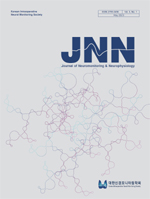Use of NMBA and reversal agent during thyroid surgery with intraoperative neuromonitoring
Use of NMBA and reversal agent during thyroid surgery with intraoperative neuromonitoring
- 대한신경모니터링학회
- Journal of Neuromonitoring & Neurophysiology
- Vol.3 No.1
-
2023.0519 - 24 (6 pages)
-
DOI : 10.54441/jnn.2023.3.1.19
- 2

Neuromuscular blocking agent (NMBA) provides adequate muscle relaxation for intubation and surgery, but their use can interfere with the interpretation of intraoperative neuromonitoring (IONM) signals. Various strategies for the use of NMBA during thyroid surgery with IONM have been proposed for both safe anesthesia and surgery, and adequate quality of IONM. Relaxant-free anesthesia or use of succinylcholine is not recommended as a routine use due to the potential of fatal complications such as laryngeal injury or malignant. Instead, the use of a single dose of rocuronium for intubation with or without a reversal agent has been widely adapted. Though spontaneous recovery of neuromuscular blockade can be achieved without a reversal agent, use of a reversal agent can shorten the time for adequate IONM. Both neostigmine and Sugammadex can be used to reverse the neuromuscular blockade. Neostigmine reverses all types of non-depolarizing NMBA, but can accompany systemic cholinergic effect, and is not effective to deep or higher level of blockade. Sugammadex only reverses the effect of aminosteroid NMBAs, but effective to all levels of blockade. Overall, appropriate strategies for the use of NMBAs and reversal agents are needed to ensure effective IONM without increasing the risk of nerve injury during surgery.
Introduction
NMBAs and Their Reversal Agents
Use of NMBA during Thyroid Surgery
Strategies for Using NMBA and Reversal Agent for IONM during Thyroid Surgery
Conclusion
Funding
Conflict of Interest
ORCID
References
(0)
(0)